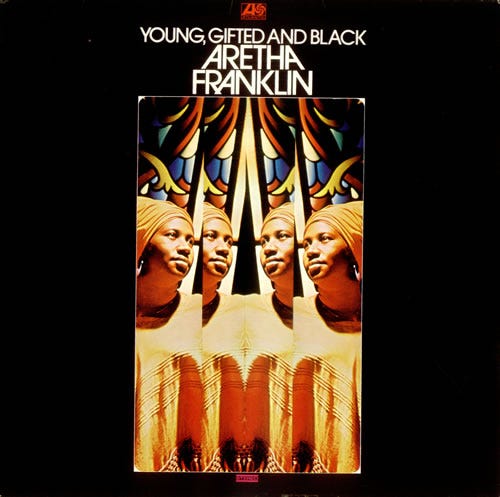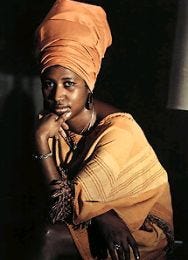Aretha Franklin had already had a long career by 1972. She had recorded a number of records for Columbia Records in styles that were largely jazz and cabaret singer settings, with only smatterings of R&B and soul, with tepid results. Her move to Atlantic Records put her into the orbit of Jerry Wexler, Arif Martin, and Tom Down and Aretha’s subsequent Atlantic releases were largely R&B and soul affairs with pop covers and the occasional look back at an earlier style.
These albums were of high quality and were produced rapidly at Muscle Shoals with a stable of available musicians who had the advantage of having played together a lot so that they were able to create the perfect groove for Lady Soul to slide into with her God-given vocal talent. At Atlantic Aretha found the mainstream success that had eluded her at Columbia. So successfully was the Atlantic formula deployed over the last few years of the 1960s that when Young Gifted and Black was released in 1972, the fact that it broke the mold and created the most perfect amalgam of R&B, soul, jazz, gospel, rock, and pop music that she would manage on any recording in her lengthy career was actually disorienting to Rolling Stone reviewer Russell Gersten:
“Aretha’s new album is quite disorienting. Except for the single, “Rock Steady,” there’s nothing left of her old Memphis-Muscle Shoals soul sound; in fact it sounds closer to a pop record than a soul record.”
That’s true if you accept that a soul record sounds pretty much as Aretha’s last several recordings had sounded. And it was largely true in that most soul records had come from two locales–Detroit and Memphis. But in 1972 that was changing. The soul center of the United States had shifted during those years towards another sound coming from another city: Philadelphia. The production was more cinematic, with a wider screen, and the soul was smoother.
Young, Gifted and Black acknowledges that in its more open, less insular sound, but what makes it such a special record in the Aretha Franklin discography is that way that it weaves the elements of Franklin’s career–jazz, R&B, soul, gospel, and pop — together in a statement record that is as direct as anything Aretha ever recorded. Franklin was a major actor in the civil rights movement and the work of Dr. Martin Luther King Jr. She sang at King’s funeral and she participated in events sponsored by Jesse Jackson’s Operation PUSH. In December of 1970 she vowed to post bail for Angela Davis, who had been arrested after being on the FBI’s Most Wanted List.
“She used her platform to inform others,” said Rev. Jesse L. Jackson. “She did not put her career before principles.”
Taking its title from lyrics by Weldon Irvine that were first recorded by Nina Simone, the album cover features Franklin in West African garb that is completely in touch with the burgeoning Black Power movement. That look stands in stark contrast to the high hairdos and funky mod clothing that Franklin had worn in the late 60s. But the most empowering thing about Young, Gifted and Black is that it sounds like Aretha Franklin arriving. It’s a very personal record in which Franklin seems very invested in nearly every song. One third of the songs were written by Franklin herself, earning her a solid reputation as a songwriter as well as a performer.
“Rock Steady” is most like her Muscle Shoals work, as Gersten noted, aided and abetted by the Memphis Horns and Bernard Purdie. “All the King’s Horses” and the gentle, jazzy “Daydreaming” are about Aretha’s recent relationships–her rocky marriage to Ted White, which ended in 1969, and her infatuation with Dennis White of the Temptations.
“Daydreaming” stands out as just an incredible sounding record that’s not like anything else you would have heard at the time. Based on a foundation of Aretha’s piano work it gets a truly dreamy sound from Donny Hathaway’s lingering chromatic electric piano and Hubert Laws’ flute. It remains grounded though, by Cornell Dupree’s rhythm guitar work. And, of course, it features Aretha’s sisters Erma and Carolyn as Aretha’s girl group backup singers. They are also present on “Rock Steady” and several other songs on the record.
There are the usual covers of R&B and soul charts as well as the covers of songs by rock and pop musicians. She does solid versions of “Didn’t I Blow Your Mind (This TIme) and “I’ve Been Loving You Too Long”. She reinterprets The Beatles’ “Long and Winding Road”, stripping it of much of its melancholy, finding instead an inner strength in the lyrics.
The closing track is a full on gospel arrangement of “Border Song” which Aretha recorded and released as a single in December 1970. Bernie Taupin’s lyrics are frequently somewhat incomprehensible but this is one of his more direct statements, clearly about alienation, bigotry, and an appeal for people to live in peace (though it’s posed as a question). It’s worth noting, though, that Elton John made a rare addition to the lyrics in the for of the final, ‘live in peace’ verse.
Here again Aretha’s piano work is the foundation of the arrangement, with soulful organ work by Billy Preston (who also plays on “Long and Winding Road” and the title track) and the backing of the Sweet Inspirations. It’s an inspired song choice that ends the album on a hopeful yet uncertain note.
Young Gifted and Black is, in many ways, similar to Carole King’s Tapestry, released in 1971–it’s a touchstone album that is addressed to a specific segment of the population (women, African Americans) and is so much of its time that it transports the listener right back to the era in which it was created. At the same time, it is timeless. Of course, Aretha had already scored a major hit with King’s song “You Make Me Feel Like a Natural Woman” and on Young Gifted and Black she continues to address issues of importance not only to African Americans in general, but to black women specifically.
There are plenty of other great performances and recordings that Aretha Franklin has left behind, recordings that will continue to inspire and delight for many years to come. But Young Gifted and Black will continue to stand as a special record in her discography at a time when black America was at a major crossing in its struggles and triumphs.
New Directions in Music is written by a single real person. It is not generated by AI. Please help spread good content by reading (Thank you!) and sharing this post with a music loving friend. If you like what you see, please sign up for a free subscription so you don’t miss a thing, or sign up for a paid subscription if you can.





Thanks for this lovely write up of an album I’ve not listened to in its entirety. I’m liking the tracks you selected for inclusion and am gonna dig into this one a little more deeply.